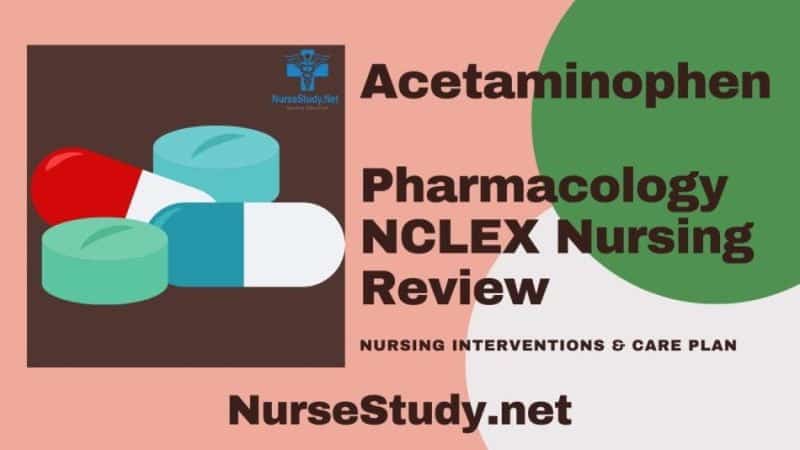Acetaminophen Nursing Considerations: Acetaminophen, commonly known as Tylenol or Paracetamol, is a widely used over-the-counter (OTC) medication for pain relief and fever reduction.
As a nurse, understanding this drug’s intricacies is crucial for optimal patient care. This comprehensive guide will explore the nursing considerations, patient teachings, and essential information about acetaminophen administration.
Overview of Acetaminophen
Generic and Brand Names
- Generic name: Acetaminophen
- Common brand names: Tylenol, Panadol, Mapap, Feverall
Classification
- Pharmacologic class: Synthetic non-opioid
- Therapeutic class: Analgesic, antipyretic
Mechanism of Action
While the exact mechanism remains unclear, acetaminophen is believed to inhibit prostaglandin synthesis in the central nervous system (CNS), resulting in pain relief and fever reduction.
Indications for Use
Acetaminophen is commonly prescribed for:
- Mild to moderate pain (headaches, muscle aches, backaches)
- Arthritis pain
- Menstrual cramps
- Toothaches
- Fever reduction
Nursing Considerations
1. Assessment
Before administering acetaminophen, nurses should:
a) Assess for allergies to acetaminophen or its components.
b) Evaluate pain levels using a standardized scale (0-10 numeric scale).
c) Check the patient’s temperature if used as an antipyretic.
d) Review the patient’s medical history, focusing on liver and kidney function.
e) Assess for pregnancy or breastfeeding status.
2. Administration
- Available forms: Tablets, capsules, liquid suspensions, suppositories, and intravenous (IV) solutions.
- Adult dosage: 325-650 mg every 4-6 hours as needed, not exceeding 4,000 mg in 24 hours.
- Pediatric dosage: 10-15 mg/kg/dose every 4-6 hours as needed.
Important: Always verify the correct dosage and frequency based on the patient’s age, weight, and specific formulation.
3. Monitoring
Nurses should monitor:
- Pain levels and fever reduction to assess effectiveness
- Liver function tests (AST, ALT) in patients at risk for hepatotoxicity
- Renal function (BUN, creatinine) in patients with kidney issues
- Signs of potential adverse effects or allergic reactions
4. Drug Interactions
Be aware of potential interactions with:
- Anticoagulants (warfarin)
- Alcohol
- Other acetaminophen-containing products
5. Adverse Effects
Watch for and report:
- Skin rashes or allergic reactions
- Nausea, vomiting, or abdominal pain
- Signs of liver toxicity (jaundice, right upper quadrant pain)
- Unusual bleeding or bruising
Patient Education
Effective patient education is crucial for safe acetaminophen use. Nurses should instruct patients to:
- Never exceed the recommended dosage (4,000 mg/24 hours for adults).
- Read labels carefully to avoid unintentional overdose from multiple acetaminophen-containing products.
- Avoid alcohol consumption while taking acetaminophen.
- Use appropriate measuring devices for liquid formulations, especially for children.
- Store medication at room temperature, out of reach of children.
- Report any unusual symptoms or side effects to their healthcare provider.
Special Considerations
Pregnancy and Breastfeeding
Acetaminophen is generally considered safe during pregnancy (Category B) and while breastfeeding. However, patients should consult their healthcare provider before use.
Elderly Patients
Older adults may be more susceptible to adverse effects. Consider lower doses or extended intervals between doses.
Patients with Liver or Kidney Disease
Use caution and consider dose adjustments in patients with hepatic or renal impairment.
Nursing Diagnoses Related to Acetaminophen Use
- Acute Pain
- Risk for Poisoning related to potential overdose
- Risk for Impaired Liver Function
- Deficient Knowledge related to medication use and safety
Conclusion
Understanding acetaminophen nursing considerations is essential for providing safe and effective patient care. By carefully assessing, monitoring, and educating patients, nurses play a crucial role in maximizing the benefits of acetaminophen while minimizing potential risks.
References
- Gerriets, V., Anderson, J., & Nappe, T. M. (2023). Acetaminophen. In StatPearls. StatPearls Publishing. Retrieved from https://www.ncbi.nlm.nih.gov/books/NBK482369/
- Yoon, E., Babar, A., Choudhary, M., Kutner, M., & Pyrsopoulos, N. (2016). Acetaminophen-Induced Hepatotoxicity: a Comprehensive Update. Journal of Clinical and Translational Hepatology, 4(2), 131–142. https://doi.org/10.14218/JCTH.2015.00052
- Gelotte, C. K., Auiler, J. F., Lynch, J. M., Temple, A. R., & Slattery, J. T. (2007). Disposition of acetaminophen at 4, 6, and 8 g/day for 3 days in healthy young adults. Clinical Pharmacology & Therapeutics, 81(6), 840-848. https://doi.org/10.1038/sj.clpt.6100121
- Bunchorntavakul, C., & Reddy, K. R. (2013). Acetaminophen-related hepatotoxicity. Clinics in Liver Disease, 17(4), 587-607. https://doi.org/10.1016/j.cld.2013.07.005
- American Society of Health-System Pharmacists. (2022). Acetaminophen. In AHFS Drug Information. Retrieved from https://www.ahfsdruginformation.com/
